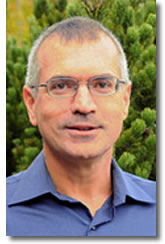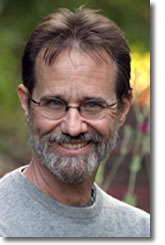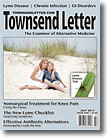|
Higher Dosages
Dr. Gordon: Another option is to go higher. Other doctors have taught us that in the right patient, we can give even higher doses. It's all about that patient's ability to detox and the resilience and capacity of their immune system. So many people, because they have such a high viral load and metal toxicity and God knows what, their inflammatory pathways don't modulate as they should. The severe herx occurs when the body doesn't quiet the inflammatory cascade. It's not necessarily the pathogen creating the herx – it's your own immune system, but your immune system can kill you. That's how you die from anthrax; the anthrax doesn't kill you, it's your immune system that kills you while it's busy killing the anthrax. The inflammation is additive.
Bodywork
Dr. Gordon: Another point – almost everyone who has been sick for a long time needs bodywork. But the problem is, if they get bodywork, they'll be sick for a week because they're full of toxins. They need very gentle detox baths – the Epsom salts baths and other types of detox baths are all helpful. They need touching: either good osteopathy or cranial frequency micro work, but it has to be done by people who understand that they cannot move fast until they find out what the patient can tolerate. Even the gentlest treatments get the lymph to begin flowing, and then these patients can become terribly ill.
The Herx
Dr. Anderson: I mentioned that in the past the worse I made someone feel, the better I thought I was doing my job, and that that was the goal of treatment. Now I have the absolute polar opposite response: I feel that if I increase people's symptoms too much, it's counterproductive if it causes disruption in an immune system that is already having a hard time figuring things out. That's why herbal medicine can be so incredible. Almost always, the information you get from herbal medicine is useful in helping you determine what the next step should be. In contrast, with antibiotics, often you're dealing with side effects, and there are some undesirable side effects in antibiotics.
Sometimes it's hard to evaluate a patient's response – are they having a therapeutic herx response, or is this a side effect? I began to realize that using antibiotics, much of my time was spent trying to sort that out. It wasn't moving me forward in relation to what the next step would be. Herbal treatments are exactly the opposite: they give me more information about how that person's body is engineered – how their detox system works and how their immune system works. That gets me to the next step in terms of how to treat them in a more efficient and effective way.
With the Byron White formulas, I can be so specific that I can actually challenge a patient effectively. I may suspect that they have babesia and not really know; at present, the only way to really know is in response to a specific provoking treatment. If they respond appropriately in a babesia-like way, then that is as good as it gets today, in terms of understanding that this person has a babesia-like infection that needs to be treated. From a challenge perspective the herbs enable me to rule in or out whether this is the appropriate treatment for a particular pathogen. Herbal therapy also gives me the ability to vary the dosage and titrate the dosage to determine which herbs will be effective and what dosage works for that person.
Dr. Gordon: For me, the beauty of the herbs is that they support the patient as well as reduce the microbial load – supporting function using the herbs, rather than taking the unidirectional approach of an antibiotic.
Layering
Dr. Anderson: We're never just dealing with one thing here – we're dealing with all of them all the time. But I think that the immune system is prioritizing for us. The symptoms that a patient presents are in response to the system's recognition of what its greatest challenge is and its efforts to deal with it. So it puts forth a dominant symptom presentation. The goal is to match that symptom presentation with the right herbal formula. Usually it is related to one particular infection or overgrowth, even though there is a whole cornucopia of infectious agents present. If you can determine what is affecting the immune system the most, then you can unlayer it. I think the treatment of the chronic infections is related to timing and layering.
In 80% of the people we see, the primary issues are babesia and bartonella, and Lyme is secondary. If you clear the babesia and bartonella, then the Lyme is vulnerable, and we can target it.
With these cases, you might use the metaphor of Lyme as the godfather in the back room. Babesia and bartonella are like little minions out there doing the dirty work. They're like tag team wrestlers. The immune system is fighting with one, and just as it's trying to pin it, the other infection jumps in and smashes you over the head with a chair. The weakened one crawls off to get strong again, and now you're fighting with this strong one. There's a back-and-forth quality to symptoms, in a progression over time. You can often hear it in a patient's history: symptom patterns that suggest a dominant babesia period and then a dominant bartonella period, for example. These kinds of sequential patterns can occur and persist over a period of years. It depends on the strength of that specific babesia organism and the strength of that particular bartonella organism, as well as the patient's health.
In some cases, bartonella and babesia might not be the first thing we treat. We both agree that we've got to treat for parasites, we've got to look at metabolic factors and detox, we've got to look at all these things before we go after babesia and bartonella. On A-BAB and A-BART, if I can get somebody up to 30 drops twice a day, very generally speaking, then they tend to be ready for the next thing. Very often in the process of gradually increasing the dose of A-BART and A-BAB, they'll flip into a different symptom presentation, and then I will change the remedy and reduce the dosage for both babesia and bartonella, little by little. The herbal remedies are useful in part because they inform the approach. As Eric said, they support the body and various systems of the body. They can strengthen the immune system and move it forward and make it more efficient.
In 20% of patients, Lyme seems to be the dominant factor. These are people who need to be treated for borrelia first – people whose symptoms of babesia and bartonella go away when you treat for the borrelia. The time range on herbal treatment can be anywhere from one or two months to six months, depending on how quickly a patient can progress through the protocol. Individual response is so varied, it's hard to generalize.
An Individualized Approach
Dr. Gordon: When it comes to training, we learn from brilliant people who are highly focused on one particular system. The problem for patients is, if you have an issue that can be solved by that system and you go to them, you'll get better. But if you don't, you'll just get frustrated. We've seen many people who have been to five or even ten clinics before they show up here. It's not that we fix them all, by any means; it's the fact that we're willing to look beyond any one approach. We don't have a fixed model; rather, we bring as many approaches to the table as possible, based on the patient's need.

 Erik Gordon, MD Erik Gordon, MD
Dr. Gordon is founder and medical director of Gordon Medical Center in Santa Rosa. He holds a medical degree from Albany Medical College, performed his family practice residency in New York State, and also has a degree in chemistry from Queens College. His professional memberships include the American College of Advancement in Medicine, International Lyme and Associated Diseases Society (ILADS), and Orthomolecular Health Medicine. Dr. Gordon's practice focuses on the treatment of chronic illness, including autoimmune diseases, autism, chronic fatigue syndrome, and Lyme. He is first and foremost a private practice physician, and his deep respect for the biochemical individuality of his patients is at the heart of his approach.

Wayne Anderson, ND
Dr. Anderson holds a degree in naturopathic medicine from National College of Naturopathic Medicine in Portland, Oregon, and additional broad-based training in health and medicine. For the first two decades of his practice, Dr. Anderson worked in a busy community-based family medical center in a region in which Lyme was endemic. As he became aware of the prevalence of chronic Lyme disease and related conditions, he realized the important part that they can play in chronic illness. In 2002, Dr. Anderson left family practice to work with Eric Gordon, MD, and focus on the treatment of Lyme disorders using leading-edge therapies from both conventional and integrative medicine.
Gordon Medical Associates
Gordon Medical is internationally recognized for successful treatment of elusive medical conditions. Initial successes included the management of fibromyalgia, heavy metal toxicity, and Lyme disease, as well as autoimmune diseases and environmentally and chemically triggered illness. GMA providers were also early proponents of bioidentical hormone balancing, the treatment of toxic mold disorders, and innovative approaches to autism. Today their approach to complementary medicine reflects a comprehensive system of many disciplines. Patients come not only from the greater San Francisco area, but the entire country, and around the world. The individualized care provided addresses a wide range of health issues from Lyme disease and chronic fatigue to chronic pain.
Gordon Medical Associates
3471 Regional Parkway
Santa Rosa, California 95403
Office: 707-575-5180
Fax: 707-575-5509
Email: info@gordonmedical.com
Lyme Resources
Classical Pearls botanical remedies are produced by:
Dr. Heiner Fruehauf, P.O. Box 402, Corbett, Oregon 97019; 503-695-2985.
Byron White Formulas can be ordered online or by phone via: ByronWhiteFormulas.com or 707-542-3206.
Editorial
Nancy Faass, MSW, MPH, is a writer and editor in San Francisco who has worked on more than 40 books for publishers that include Elsevier, Harper, McGraw-Hill, Mosby, and others. Director of the Writers' Group, she also provides articles, white papers, and writing for the Web. For more information, see www.HealthWritersGroup.com or contact info@HealthWritersGroup.com.
Page 1, 2, 3 |
![]()
![]()
![]()





 Erik Gordon, MD
Erik Gordon, MD